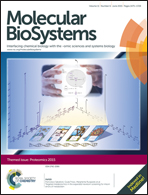Exploitation of complement regulatory proteins by Borrelia and Francisella†
Abstract
Pathogens have developed sophisticated mechanisms of complement evasion such as binding to the host complement regulatory proteins (CRPs) on their surface or expression of CRP mimicking molecules. The ability of pathogens to evade the complement system has been correlated with pathogenesis and host selectivity. Hitherto, little work has been undertaken to determine whether Borrelia and Francisella exploit various CRPs to block complement attack. Seventeen Borrelia (twelve species) and six Francisella (three subspecies) strains were used to assess their ability to bind human, sheep and cattle CRPs or mimic membrane associated complement regulators. A series of experiments including affinity ligand binding experiments, pull-down assays and mass spectrometry based protein identification, revealed an array of CRP binding proteins of Borrelia and Francisella. Unlike Francisella, Borrelia strains were able to bind multiple human CRPs. Three strains of Borrelia (SKT-4, SKT-2 and HO14) showed the presence of a human CD46-homologous motif, indicating their ability to possess putative human CD46 mimicking molecules. Similarly, five strains of Borrelia and two strains of Francisella may have surface proteins with human CD59-homologous motifs. Among ovine and bovine CRPs, the only CRP bound by Francisella (LVS, Tul4 strain) was vitronectin, while ovine C4BP, ovine factor H and bovine factor H were bound to Borrelia strains SKT-2, DN127 and Co53. This study presents an array of proteins of Borrelia and Francisella that bind CRPs or may mimic membrane-CRPs, thus enabling multiphasic complement evasion strategies of these pathogens.

- This article is part of the themed collection: Proteomics

 Please wait while we load your content...
Please wait while we load your content...